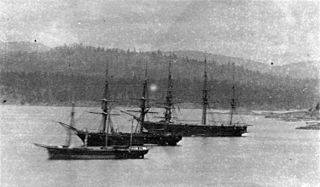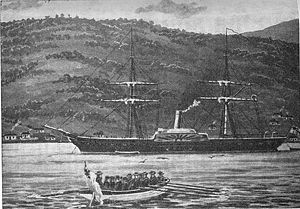HMS Enterprise was a 24-gun sixth-rate of the French Navy captured by HMS Triton on 7 May 1705. She was registered as a Royal Navy ship on 1 June 1705 and commissioned shortly afterwards. She served in the Mediterranean and with Admiral Byng's squadron at the Downs. She was wrecked in 1707 with the loss of all hands.

HMS Prince of Wales was one of six 121-gun screw-propelled first-rate three-decker line-of-battle ships of the Royal Navy. She was launched on 25 January 1860.

The Pearl-class cruiser was a third-class protected cruiser designed by Sir William White for the Royal Navy. Nine ships were built to this design, five of which were paid for by Australia under the terms of the Imperial Defence Act of 1887 to serve in Australian waters.

The Sail and Steam Navy List: All the Ships of the Royal Navy 1815–1889 by Rif Winfield and David Lyon is a historical reference work providing details of all recorded ships in commission or intended to serve in the Royal Navy from 1815 to 1889. Where available in Admiralty records, it gives the location of construction, dates of construction, principal dimensions and tonnage, armament, machinery and fate of every ship of the Royal Navy over the period.

HMS Halifax was a ship-rigged sloop of the Merlin class built in 1806 for the British Royal Navy at the Naval Yard in Halifax, Nova Scotia. Built to fill a pressing need for coastal patrol sloops on the North American Station, Halifax was one of the few warships built at Halifax Naval Yard in the Age of Sail as the yard's primary function was supply and refit.

Post ship was a designation used in the Royal Navy during the second half of the 18th century and the Napoleonic Wars to describe a sixth-rate ship that was smaller than a frigate, but by virtue of being a rated ship, had to have as its captain a post captain rather than a lieutenant or commander. Thus ships with 20 to 26 guns were post ships, though this situation changed after 1817.

HMS Malacca was a 17-gun wooden sloop of the Royal Navy. She was ordered on 9 November 1847 from Moulmein, Burma to be built of teak. As a Surveyor's Department design, Malacca was based on the Conflict designed sloop which was approved on 9 December 1848. After launching in April 1853 she was commissioned the following month to be sailed to England for the fitting of her engine. She entered British Naval service in 1854 and served three commissions including action in the Russian War 1854 - 55 before being sold in 1869. Her resale to Japan, she served in the Japanese Navy as a training ship until broken in 1906.
HMS Nereus was a 46-gun modified Leda-class fifth-rate frigate built for the Royal Navy during the 1810s. She was never commissioned and was converted into a store ship in 1843 for service in South America. The ship was sold for into civilian service in 1879.
HMS Thisbe was a 46-gun modified Leda-class fifth-rate frigate built for the Royal Navy during the 1820s. The ship was never commissioned and spent her entire career in reserve or on third-line duties. She was converted into a depot ship in 1850 and then into a floating church in 1863. Thisbe was replaced by a shore-based establishment, All Souls Chapel, in 1891 and sold for scrap the following year.
HMS Skylark was a 10-gun Cherokee-class brig-sloop built for the Royal Navy during the 1820s. She was wrecked in 1845.
HMS Spey was a 10-gun Cherokee-class brig-sloop built for the Royal Navy during the 1820s. She was wrecked in 1840.
HMS Wizard was a 10-gun Cherokee-class brig-sloop built for the Royal Navy during the 1820s. She was wrecked in 1859.

HMS Talbot was a 28-gun Atholl-class sixth-rate frigate built for the Royal Navy during the 1820s.
HMS Comus was an 18-gun sloop, the name ship of her class, built for the Royal Navy during the 1820s.
HMS Medina was a 2-gun Merlin-class paddle packet boat built for the Royal Navy during the 1830s. The ship remained in ordinary until she was commissioned in 1848. She was converted into a survey ship in 1856 and was broken up in March 1864.

The Merlin-class packet boat of 1838 was a Sir William Symonds design that was approved on 2 April 1838. The vessels were to be built for steam mail packet service on the Liverpool to Dublin route. The initial two ships were ordered in the fall of 1838 from Pembroke Dockyard. The third vessel (Medina) was ordered in 1839, also from Pembroke. When completed all vessels were used on the Liverpool station. In 1848 all three were in the Mediterranean on mail packet service. Merlin went to the Baltic during the Russian Was as a survey ship. Medusa went to the Black Sea. Medina remained in the Mediterranean being converted to a survey ship for Mediterranean service. Merlin served on the West Coast of Africa and was sold for commercial use in 1863. Medina was sold at Malta in April 1864. Medusa was converted to a tugboat in 1861 and remained in that service until sold in 1872.
HMS Rhadamanthus was one of the initial steam powered vessels built for the Royal Navy. On 10 January 1831 the First Sea Lord gave orders that four paddle vessels be built to competitive designs. The vessels were to be powered by Maudslay, Son & Field steam engines, carry a schooner rig and mount one or two 10-inch shell guns. Initially classed simply as a steam vessel (SV), she was re-classed as a second-class steam sloop in 1846. Designed by Thomas Roberts, the Master Shipwright of Plymouth. She was launched and completed in 1832, She was converted into a transport in 1841 then in 1851 she was a troopship and by the 1860s she was a transport again. Her breaking was completed in February 1864.
The Stromboli class was a group of two vessels designed by Sir William Symonds the Surveyor of the Navy. The design was approved on 29 August 1838. The vessels were of the Medea design but were altered to the new draught derived from the Gorgon. The ships were initially classified as Steam Vessels Second Class (SV2) and were later classified as First Class sloops. The ships were built in two Royal Dockyards. Both ships were at the bombardment of Acre in 1840. Both were in the Black and Azov seas during the Russian War. They served on various stations of the Empire. Vesuvius was sold in 1865 and Stromboli in 1866. Both were broken by White at East Cowes on the Isle of Wight.
The Alecto-class steam vessels (SV3) later reclassed as Third Class Sloops, were designed by Sir William Symonds, the Surveyor of the Navy. The design was approved on 12 April 1839. Initially four vessels were ordered and completed. A fifth unit was ordered (Rattler), but was reordered as a screw propelled vessel. And a sixth unit had been ordered but was requested to be reordered to a different design. The screw driven Rattler participated in the first of three 'tug o- wars with the Alecto. The vessels all participated during the Russian War. All had gone to the breakers by the mid-1860s.








